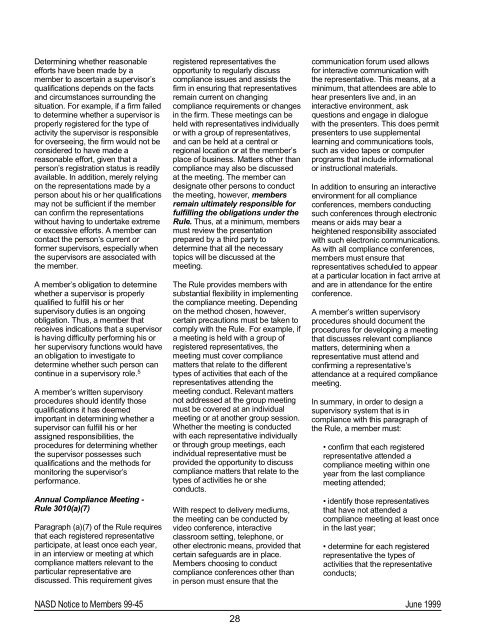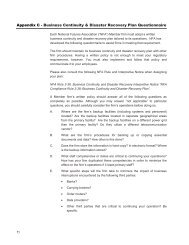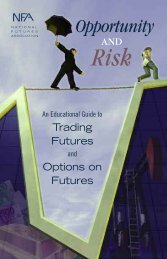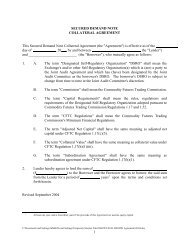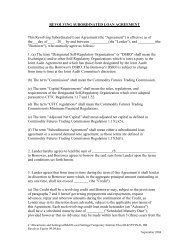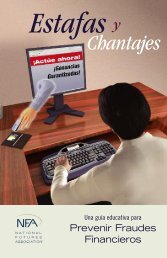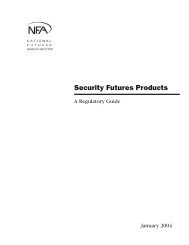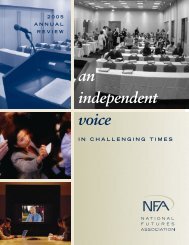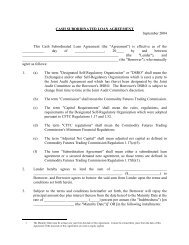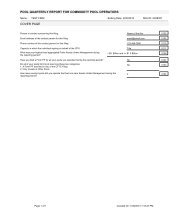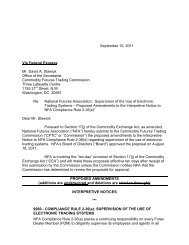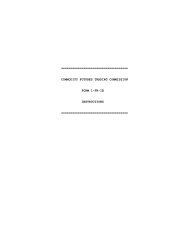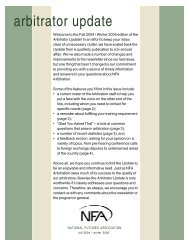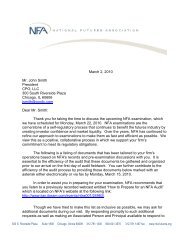NASD Notice to Members 99-45 - National Futures Association
NASD Notice to Members 99-45 - National Futures Association
NASD Notice to Members 99-45 - National Futures Association
You also want an ePaper? Increase the reach of your titles
YUMPU automatically turns print PDFs into web optimized ePapers that Google loves.
Determining whether reasonable<br />
efforts have been made by a<br />
member <strong>to</strong> ascertain a supervisor’s<br />
q u a l i fications depends on the facts<br />
and circumstances surrounding the<br />
situation. For example, if a firm failed<br />
<strong>to</strong> determine whether a supervisor is<br />
properly registered for the type of<br />
activity the supervisor is responsible<br />
for overseeing, the firm would not be<br />
considered <strong>to</strong> have made a<br />
reasonable effort, given that a<br />
person’s registration status is readily<br />
available. In addition, merely relying<br />
on the representations made by a<br />
person about his or her qualific a t i o n s<br />
may not be sufficient if the member<br />
can confirm the representations<br />
without having <strong>to</strong> undertake extreme<br />
or excessive efforts. A member can<br />
contact the person’s current or<br />
former supervisors, especially when<br />
the supervisors are associated with<br />
the member.<br />
A member’s obligation <strong>to</strong> determine<br />
whether a supervisor is properly<br />
q u a l i fied <strong>to</strong> fulfill his or her<br />
supervisory duties is an ongoing<br />
obligation. Thus, a member that<br />
receives indications that a supervisor<br />
is having difficulty performing his or<br />
her supervisory functions would have<br />
an obligation <strong>to</strong> investigate <strong>to</strong><br />
determine whether such person can<br />
continue in a supervisory role. 5<br />
A member’s written supervisory<br />
procedures should identify those<br />
q u a l i fications it has deemed<br />
important in determining whether a<br />
supervisor can fulfill his or her<br />
assigned responsibilities, the<br />
procedures for determining whether<br />
the supervisor possesses such<br />
q u a l i fications and the methods for<br />
moni<strong>to</strong>ring the supervisor’s<br />
p e r f o r m a n c e .<br />
Annual Compliance Meeting -<br />
Rule 3010(a)(7)<br />
Paragraph (a)(7) of the Rule requires<br />
that each registered representative<br />
participate, at least once each year,<br />
in an interview or meeting at which<br />
compliance matters relevant <strong>to</strong> the<br />
particular representative are<br />
discussed. This requirement gives<br />
registered representatives the<br />
opportunity <strong>to</strong> regularly discuss<br />
compliance issues and assists the<br />
firm in ensuring that representatives<br />
remain current on changing<br />
compliance requirements or changes<br />
in the firm. These meetings can be<br />
held with representatives individually<br />
or with a group of representatives,<br />
and can be held at a central or<br />
regional location or at the member’s<br />
place of business. Matters other than<br />
compliance may also be discussed<br />
at the meeting. The member can<br />
designate other persons <strong>to</strong> conduct<br />
the meeting, however, m e m b e r s<br />
remain ultimately responsible for<br />
f u l filling the obligations under the<br />
Rule. Thus, at a minimum, members<br />
must review the presentation<br />
prepared by a third party <strong>to</strong><br />
determine that all the necessary<br />
<strong>to</strong>pics will be discussed at the<br />
m e e t i n g .<br />
The Rule provides members with<br />
substantial flexibility in implementing<br />
the compliance meeting. Depending<br />
on the method chosen, however,<br />
certain precautions must be taken <strong>to</strong><br />
comply with the Rule. For example, if<br />
a meeting is held with a group of<br />
registered representatives, the<br />
meeting must cover compliance<br />
matters that relate <strong>to</strong> the different<br />
types of activities that each of the<br />
representatives attending the<br />
meeting conduct. Relevant matters<br />
not addressed at the group meeting<br />
must be covered at an individual<br />
meeting or at another group session.<br />
Whether the meeting is conducted<br />
with each representative individually<br />
or through group meetings, each<br />
individual representative must be<br />
provided the opportunity <strong>to</strong> discuss<br />
compliance matters that relate <strong>to</strong> the<br />
types of activities he or she<br />
conducts.<br />
With respect <strong>to</strong> delivery mediums,<br />
the meeting can be conducted by<br />
video conference, interactive<br />
classroom setting, telephone, or<br />
other electronic means, provided that<br />
certain safeguards are in place.<br />
<strong>Members</strong> choosing <strong>to</strong> conduct<br />
compliance conferences other than<br />
in person must ensure that the<br />
communication forum used allows<br />
for interactive communication with<br />
the representative. This means, at a<br />
minimum, that attendees are able <strong>to</strong><br />
hear presenters live and, in an<br />
interactive environment, ask<br />
questions and engage in dialogue<br />
with the presenters. This does permit<br />
presenters <strong>to</strong> use supplemental<br />
learning and communications <strong>to</strong>ols,<br />
such as video tapes or computer<br />
programs that include informational<br />
or instructional materials.<br />
In addition <strong>to</strong> ensuring an interactive<br />
environment for all compliance<br />
conferences, members conducting<br />
such conferences through electronic<br />
means or aids may bear a<br />
heightened responsibility associated<br />
with such electronic communications.<br />
As with all compliance conferences,<br />
members must ensure that<br />
representatives scheduled <strong>to</strong> appear<br />
at a particular location in fact arrive at<br />
and are in attendance for the entire<br />
c o n f e r e n c e .<br />
A member’s written supervisory<br />
procedures should document the<br />
procedures for developing a meeting<br />
that discusses relevant compliance<br />
matters, determining when a<br />
representative must attend and<br />
c o n firming a representative’s<br />
attendance at a required compliance<br />
m e e t i n g .<br />
In summary, in order <strong>to</strong> design a<br />
supervisory system that is in<br />
compliance with this paragraph of<br />
the Rule, a member must:<br />
• confirm that each registered<br />
representative attended a<br />
compliance meeting within one<br />
year from the last compliance<br />
meeting attended;<br />
• identify those representatives<br />
that have not attended a<br />
compliance meeting at least once<br />
in the last year;<br />
• determine for each registered<br />
representative the types of<br />
activities that the representative<br />
c o n d u c t s ;<br />
<strong>NASD</strong> <strong>Notice</strong> <strong>to</strong> <strong>Members</strong> <strong>99</strong>-<strong>45</strong> June 1<strong>99</strong>9<br />
28


